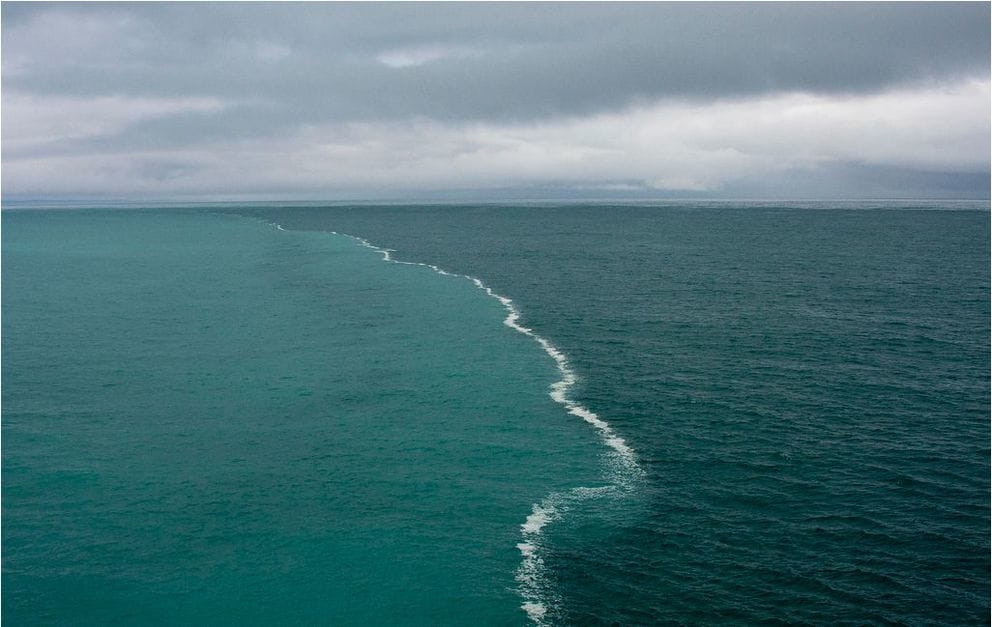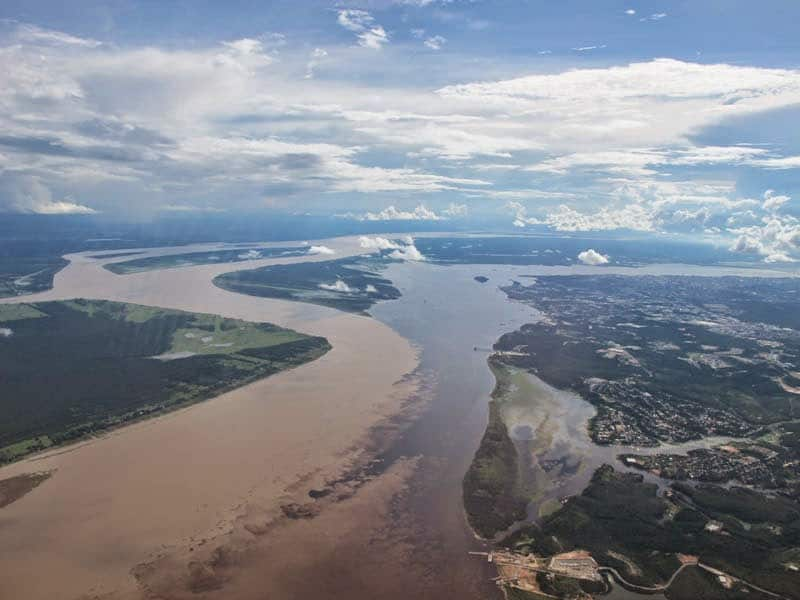As humans do something seldom in the simple way, they decided to give the northern top of the North Pacific Ocean a separate name. Called it the Gulf of Alaska. But really we are sailing in the Pacific Ocean and the weather generated here comes mainly from far away from the West or South Pacific. Because of the high stretch of open water any bad weather can come over without any hindrance and often increases in “nastiness” while doing so due to relatively warm waters here. There is a lot of cold water flowing out but it does not stand the competition with the warmer waters which come up the coast from the south. At some places where this glacier water comes out into the ocean, it almost looks like that the waters do not mix. I have seen that myself a few times and as the photo below shows, it looks quite impressive. The salty sea water has a hard time mixing with the sediment laden fresh water coming from the glaciers.

Meeting of the Waters, somewhere near the Prince William Sound. (Photo courtesy: Ken Butland, professor of ocean sciences at University of California-Santa Cruz)
Other places where I have seen this occurring is in Germany where the Rhine and Mosel rivers merge and on the Amazon River, just outside Manaus. Here the Solimoes River (the main tributary of the Amazon) meets the Rio Negro coming from Manaus. The Solimoes River is sweet and has a lot of sand sediment in it and the Rio Negro is an acid river which carries very little in sediment. When these come together the water has a hard time mixing but eventually does of course. If we come across it somewhere and it is in deep water we try to sail through it right on the boundary so guests can see a different water color on each side of the ship. The mixing effect of the propellers then blurs the border line for a while. But it is amazing how fast this borderline is re-established. In Alaska I have not seen it for a long time, not since Hal pulled out of Prince William Sound.

Meeting of the Waters. Just outside Manaus where the Solimoes River and the Rio Negro meet to go downstream as the Amazon. (Courtesy: unknown photographer, somewhere on the Internet)
We used to call there for a long number of years, stopping at Valdez and then sailing up College Fjord. We could only do that when we did not go to Glacier Bay but to Hubbard Glacier. I like Hubbard Glacier but it is very unpredictable. Sometimes it produced so much ice that we could not even get in the Bay and then had to disappoint our guests. Glacier Bay is a bit of a calmer experience and Marjorie Glacier normally obliges with a bit of calving and you get a full day and the Ranger Experience thrown in as well. Thus with us calling at Glacier Bay has the knock on effect that we have to spend our last day at sea. To me that makes sense as well; if you are on a cruise then part of the experience is to enjoy the ship itself.
The Gulf is normally a quiet sea from May to the end of September when the first winter storms start to come through. Then it becomes very un-pleasant here. For those of you who have watched The Deadliest Catch will get the idea. The fishing boats are of course a lot smaller than we are and sometimes they are out in the open when a normal person would have sought shelter. But still the Gulf can cause the ship to get in a roller coaster experience if the storm happens to be in synch with the cruise schedule. The last time it happened to one of our ships was in 2012 when the Statendam under the command of Captain Consen had to cancel Glacier Bay and race to Seward to be inside before the approaching storm would hit the coast. Not very nice to cancel the high light of the cruise but he had to keep the schedule as a full ship of guests were coming down from the interior with nowhere else to go. Frans went home in Seward and was relieved by Yours Truly and the first thing I did was to cancel departure. The swell outside Resurrection Bay was over 25 feet high and not really safe to meet head on. Luckily I could make up the lost time the next day and we could call at Glacier Bay as planned. The ones that relly enjoyed themselves were the crew who had two over nights in Seward. And although Seward is not known for its night life, the crew always finds a way to turn things to their advantage. Even if it only using the free Wi-Fi in the terminal.
Tomorrow we are in Seward and the ship should be docked just after 05.00 hrs. The first guests will be leaving just after 05.30 and then the first new guests will arrive early in the afternoon. The weather looks good and I need that because the sailors need to train with the Tenders. It looks that I will need my sun glasses.

July 16, 2017 at 7:39 pm
Our first cruise was on the Ryndam sailing from Seward. I woke up on our first day at sea (August 1, 2005) and peeked out our window on the lower promenade deck and could not believe the beauty of College Fjord. That was our first glacier experience and will be with me forever! When did they stop going to College Fjord? We later did a Prince William Sound tour but it did not compare to the unexpected beauty of the glaciers that day on the Ryndam.
Our Captain was Maurits Groothuis.
July 17, 2017 at 10:34 am
Thank you for reading my blog.
We stopped in 2008 when we received more permits to call at Glacier Bay. And then we could offer close by Glacier sightings compared to the gamble of going to Hubbard and being locked out by the ice.
Best regards
Capt. Albert